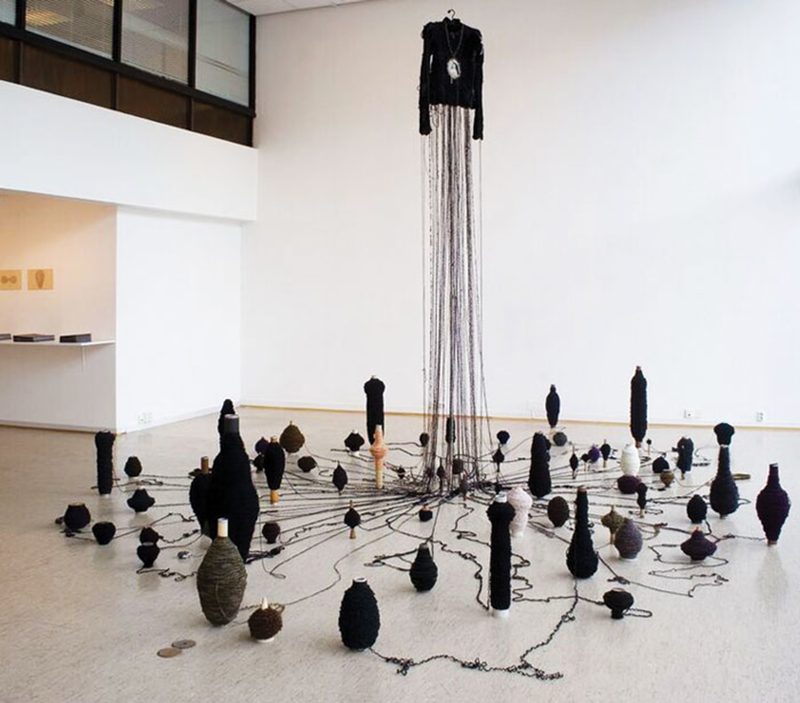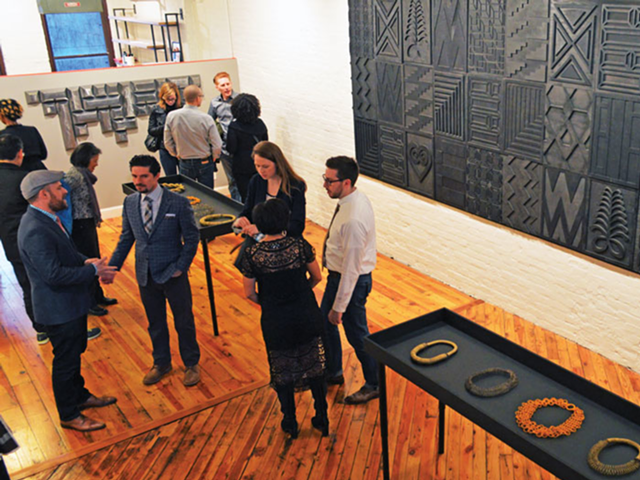If you keep up on art news at all, you probably saw headlines a couple weeks ago declaring that New York’s Guggenheim Museum would be installing a solid gold toilet. The sculpture, made by Maurizio Cattelan, “offers a wink to the excesses of the art market” while also embodying “the inescapable physical realities of our shared humanity,”according to the museum’s PR team. This endorsement, or defense, of Cattelan’s aureate latrine felt a little too simple. To me, the work felt more like a willing participant in capitalist avarice than a critique of it.
If Cattelan took something of artificial wonder and alchemized it into a banality, the artists in the Contemporary Arts Center’s latest exhibit do the opposite. In Unraveled: Textiles Reconsidered, nine artists deconstruct and reanimate clothing, blankets, rugs and other fabrics into emblems of political and personal expression. Whereas Cattelan recodes society’s cliché symbol of success (gold) into something everyone uses (a toilet), these artists take humble possessions we all own (clothing, textiles) and weave them into art.
In Unraveled, textiles are mined for their metaphors to explore aspects of identity and interconnectedness. Adrian Esparza’s “Dawn,” an azure weft spun around a grid of nails using a cheap serape’s single thread, may act as the exhibit’s skeleton key. It depicts, abstractly, a 1908 photograph of the Mount Adams incline, a long-demolished structure. Its title refers to the Procter & Gamble detergent — which Esparza reserves a certain nostalgia for — yet it could just as easily indicate artistic genesis.
Esparza’s work, which risks becoming aesthetic kitsch, ultimately relishes in both visual and conceptual dissonance. By deconstructing a factory-made blanket and reinvesting time into it to forge something tied to history, place and memory, Esparza offers an alternative to both textile production and industrialized art.
Amid the exhibit’s many exaltations of woven dross, Noel W. Anderson’s “Black Past-iche (to be looked at far and away)” stands out. A floral rug found in a dumpster that the artist adopted for his own apartment before incorporating it as a piece, its surface contains pasted pages from Ebony, a magazine with a primarily black readership. Coincidentally, over at the Cincinnati Art Museum, another carpet — this one untitled and “made” by Rodney McMillian, hangs on the wall as a part of the 30 Americans exhibit, which consists of contemporary African-American artists. Both are daring, grimy and somehow grotesquely whimsical. They can be read as documents of neglect, but also as gestures of possibility.
Unlike the other works, Anderson’s piece challenges authorship by trading creation for recognition and deeming it art. It works.
A handful of the artists in Unraveled use textiles as a way to edit political realities into new hopes. Others explore the boundaries a fabric’s memory can push to.
So often we see language from textiles used to explain society: friendships and communities are woven, threaded, tangled. Cleverly, the artists in Unraveled reverse this metaphor. But if the works revolve around a newfound impulse to re-ground our experience in the haptic, they ignore — or exploit — the fact that they go untouched in the gallery space. Because the media is so tactile, there’s a friction that builds as each installation sits there, trying to transcend materiality.
Maybe this is the exhibit’s beautiful failure.
Though it can be interpreted as an antidote to the internet and our addictive screens, the exhibit’s visual texture, its inanimations, might not be enough. Interestingly, the group of artists, who span multiple countries and whose median age is around 47, lack participants fully immersed in the digital age since birth, and this forfeits an opportunity for a younger generation to comment on our increasingly simulated world via textile media.
I read once that the word “unravel” is, at its root, a contronym — a word that means two opposite things. It can either mean to tangle, or to untangle. Unraveled seems to play on this, suggesting that on some level, most of the art in the exhibit is contronymous. To create, many of these artists must first destroy. It is within this act where the exhibit’s strange virtue lies.
UNRAVELED: TEXTILES RECONSIDERED is on display at the CAC through Aug. 14. More info: contemporaryartscenter.org.






